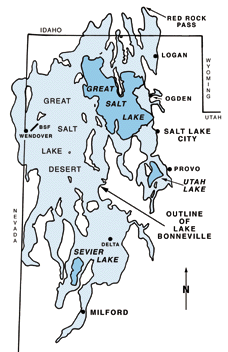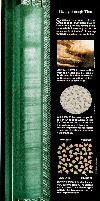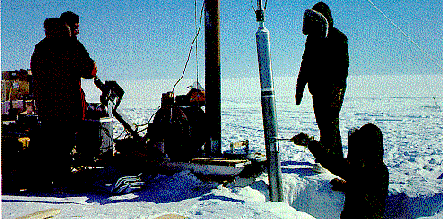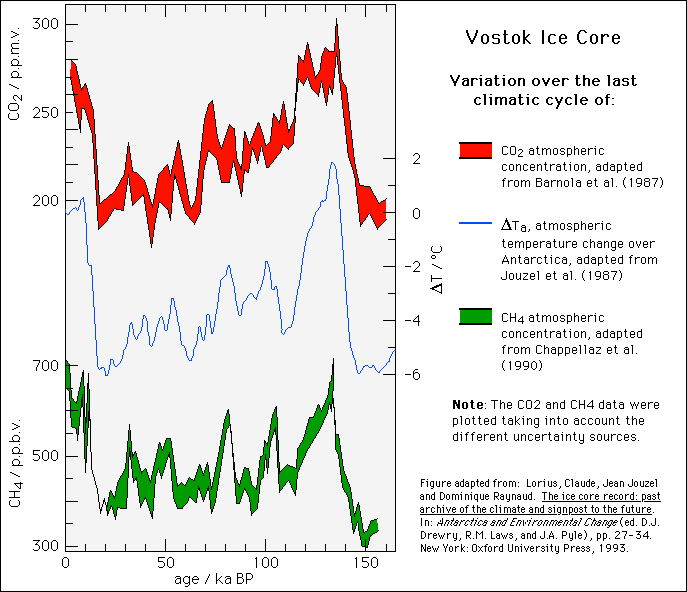To reconstruct past climates, scientist must examine all the available evidence. Unfortunately, the evidence only gives a general understanding of what the climate was like.
 |
Fossil pollen of a tundra plant collected in a layer of sediment in New England and dated to be 12,000 years old suggests that the climate of that region was much colder than it is today.
Animal remains - hard parts of beetles
Other evidence of global climatic change comes from core samples taken from ocean floor sediments. The sediments contain the remains of calcium carbonate shells of organisms that once lived near the surface. Because certain organism live within a narrow range of temperature, the distribution and type of organisms within the sediment indicate the surface water temperature.
 |
Several types of geological features aare characteristic of glaciation. As glaciers advance, rocks frozen to their base gouge the bedrock below. These rocks indicate the direction of past glacial movement.
The ridges of sediment, known as moraines (see figure right), are deposited at the front and sides of the ice sheets. When the ice melts, these ridges are left behind, marking the farthest advance of the ice sheet.
Moraines are formed by the deposition of rock material carried at the edges of glaciers. Note that where two glaciers meet and flow together a moraine is also deposited on the surface of the glacial ice. Oblique aerial view of Brady Glacier, Fairweather Range. Glacier Bay district, Southeastern Alaska region, Alaska.
Over the thousands of years, changes in regional and global hydrological balance are often reflected in lake levels that act like giant rain gauges to record large-scale changes in precipitation.
Past African lake levels, for example, were relatively high during periods of enhanced mean precipitation during the early-middle Holocene.
 |
Great Salt Lake (Utah) was once Lake Bonneville which covered much of the Great Basin.
|
|
|
|
|
|
Still another evidence of climatic change comes from the study of annual growth rings of trees, called dendrochronology. As the tree grows, it produces a layer of wood cells under its bark. Each year's growth appears as a ring. The changes thickness of the rings indicate climatic changes that may have taken place from one year to the next.
Tree rings are only useful in regions that experience an annual cycle and in trees that are stressed by temperature or moisture during their growing season. The growth of tree rings has been correlated with precipitation and temperature patterns for hundreds of years into the past in various regions of the world.
In summary:
Most of the oxygen in sea water is composed of 8 protons and 8 neutrons in ts nucleus, giving it an atomic weight of 16. However, about one out of every thousand oxygen atoms contains an extra 2 neutrons, giving it an atomic weight of 18.
When ocean water evaporates, the heavy oxygen 18 tends to be left behind. Consequently, during periods of glacier advance, the oceans, which contain less water, have a higher concentration of oxygen 18. Since the shells of marine organisms are constructed from the oxygen atoms existing in ocean water, determining the ratio of oxygen 18 to oxygen 16 within these shells yields information about how the climate may have varied in the past.
The analysis of oxygen isotopes in ice cores is based on an slightly different principle. Since ice is composed of hydrogen an oxygen, examining the oxygen-isotope ratio in ancient cores provides a past record of temperature trends. Generally, the colder the air when the snow fell, the richer the concentration of oxygen 16 in the record.
The amount of O18 in water vapor depends on temperature. Warmer air contains a larger fraction of O18 which is heavier. The ratio between the two (O18 / O16) remains frozen when incorporated into a stratified deposit.
Therefore, oxygen isotope analysis can be applied to:
 |
 |
 |